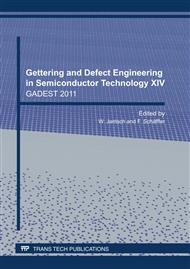p.243
p.249
p.253
p.259
p.263
p.267
p.275
p.285
p.289
Interaction of Point Defects with Impurities in the Si-SiO2 System and its Influence on the Interface Properties
Abstract:
The results of an investigation of the point defects (PD) generation, redistribution and interaction with impurities in the Si-SiO2 system during the process of its formation in use of of electron paramagnetic resonance (EPR) and nuclear magnetic resonance (NMR) spectra are presented. The type and density of the point defects that are generated in the Si surface layer during thermal oxidation depend on the oxidation conditions: temperature, cooling rate, oxidation time and impurity content. The difference between interface properties of n- and p-type wafers could be related to different Fermi level position at the interface and to different PD densities in volume.
Info:
Periodical:
Pages:
263-266
Citation:
Online since:
August 2011
Keywords:
Price:
Сopyright:
© 2011 Trans Tech Publications Ltd. All Rights Reserved
Share:
Citation:


